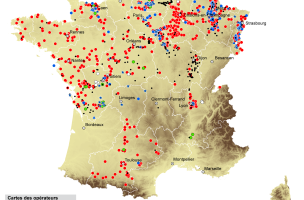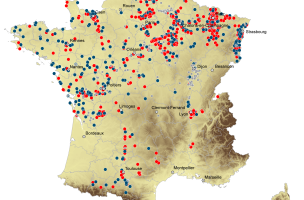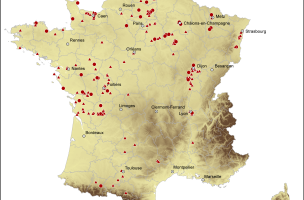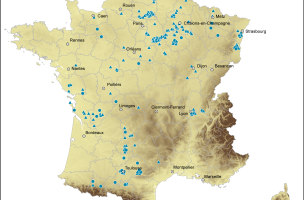You are here
Habitats and land use during the Bronze Age and the Hallstatt period (First Iron age) (2200 – 600 BC)
The creation of a research group and a database relative to settlement patterns in metropolitan France during the Bronze Age and the beginning of the Hallstatt period (First Iron Age).
Since the 1990s, discoveries relative to late prehistory, and more specifically the Bronze Age and beginning of the Iron Age, have increased exponentially. Preventive archaeology operations have greatly contributed to this phenomenon. The publication of a synthesis following the Lons-le-Saunier colloquium (Mordant et al., 1992) fully illustrates the advances that have been made. The most significant impacts resulting from research in preventive archaeology concern habitat types, chronological resolutions and the characterization of funerary practices. Multidisciplinary approaches have contributed to advances in other domains, such as the economy and paleoenvironment. The goal of the “Bronze” national investigation is to take full advantage of the large quantity of documentation accumulated for this transitional period. This is a collaborative project involving more than 70 researchers affiliated with different organisms.
Questions and objectives
The Bronze Age and the beginning of the Iron Age constitute a transitional period in the development of agropastoral societies in western Europe. Radical transformations took place in these societies and their agricultural practices as part of the modalities of the formation of terroirs and territories. At the end of the Neolithic, we observe the development of metallurgy, long-distance exchange networks and the establishment of a settlement foundation.
Under the aegis of Inrap, the accumulation of data relative to this period (habitation, land use) led to the creation of a collaborative research group whose aim is to realize documentary assessments, in regional groups. Initiated by the scientific and technical directorate of Inrap, the objective of this national investigation is to constitute a database relative to settlement patterns in metropolitan France during the Bronze Age and the beginning of the Hallstatt period.

Map of the sites recorded on a form in November 2011
© Audouit Frédéric, Inrap, 2011

Map of the operators: state November 2011
© Audouit Frédéric, Inrap, 2011

Nature of the intervention: state November 2011
© Audouit Frédéric, Inrap, 2011

habitat and funerary sites of the Early Bronze: state November 2011
© Audouit Frédéric, Inrap, 2011

Habitat and funerary sites of the Middle Bronze: state November 2011
© Audouit Frédéric, Inrap, 2011

Habitat and funerary sites of the Final Bronze: state November 2011
© Audouit Frédéric, Inrap, 2011

Habitat and funerary sites of the Hallstatt period
© Audouit Frédéric, Inrap, 2011
A critical evaluation of the field data
The research project is structured around a database coupled with a geographic information system (GIS). It is based on a critical evaluation of the field data, whether or not they are associated with preventive archaeology operations. The multiplication of these operations, from diagnostic interventions to extensive excavations, revealed a very large number of occupations associated with early Protohistory. This heterogeneous and disparate information had not been systematically processed. In developing a database that takes the high variability of occupation types across a region into account, from the isolated pit to a network of sites, the aim of this investigation is to apprehend at different scales the phases in the construction of territories during early Protohistory.
The inventory and recording of this data enable them to be homogenized at the scale of metropolitan France. The work often requires a reexamination of the field information (field reports, reanalysis of artifact assemblages, etc.), as well as the creation of a shared reference base, in the chronological domain for example.
With more than 2000 recording sheets corresponding to 2800 sites, the database of the Bronze investigation constitutes, at the European scale, a model for the exploitation of heterogeneous data yielded by preventive archaeology. This research tool is continually evolving, as is shown for example by the recent development of a specific module for the funerary domain. It enables the aggregation of qualitative and quantitative information and its processing with the aid of a GIS.
Main results
In November 2011, at round table in Bayeux, a first evaluation of the progress of this research project was made (Carozza et al., in press). This investigation has shown that information relative to the Bronze Age is often very ephemeral and often originates from archaeological diagnostics or excavations conducted over very large surfaces. A diachronic analysis of the data also shows the high variability of the frequency of settlement evidence.
During the Middle Bronze (ca. 1500 BC), we observe a strong decrease in the evidence for settlement relative to the preceding period in some regions. In other regions, where the Early Bronze is often under-represented, we observe an increase in sites and a new equilibrium between habitats and funerary contexts.
The end of the Bronze Age (ca. 800 BC) seems to coincide with a phase of settlement densification across metropolitan France, with a significant lack of burials in many regions.
We should note that these general trends should be weighted. Based on research conducted in Normandy for the Middle Bronze, or the Limagne basin for the Early Bronze, we observe the emergence of “high settlement centers”, while at the same time in other regions, there is evidence for decreasing settlements.
In response to this observation, the national investigation was reoriented around 3 main themes:
- Habitat, architecture and the construction of domestic spaces;
- Modes of appropriating space, from the farm to the village;
- From territory to environment.
In the end, the Bronze Age could appear to be a period during which a new rurality was constructed, but this is far from the case. The regional syntheses presented show that while this period is characterized by some global changes (demographic growth at the end of the Bronze Age, many climatic changes during the Middle Bronze, or the transition between the Bronze and the Iron Ages), only the power of sociocultural operators can explain the deep differences observed.
This is a decisive period in the construction of landscapes. The impact of agricultural and pastoral production activities had significant consequences for the environment, even in mountain environments which were previously only scarcely anthropized. At the same time, the establishment of road networks and land parceling reveals changes in practices (e.g. small animal-traction agriculture). Habitat types (functions, networks) are an excellent indicator of the mutations that operated during the Bronze Age.
The database, a collaborative support and tool
The results of this national investigation were presented at the 18th annual congress of the European Association of Archaeologists (EAA), held in Helsinki in September 2012. The use of metadata originating from preventive contexts and modelling were emphasized (Carozza et al., 2012).
The network set up in most of the regions initiated the creation of several collaborative research projects. These collaborations contributed to the syntheses and presentations made at the BOAT 1550 BC/APRAB colloquium in Boulogne-sur-Mer in October 2012, at the APRAB colloquium on the Middle Bronze in June 2014 in Strasbourg, and at the Nord-Sud colloquium held in November 2016 in Dijon, on the subject of habitats during the Neolithic and Bronze Age.
Références CITED (in french)
MORDANT (Claude) dir., RICHARD (Annick) dir. — L’habitat et l’occupation du sol à l’Age du Bronze en Europe : actes du colloque international de Lons-le-Saunier, 15-19 mai 1990. Paris : Éditions du CTHS, 1992, 480 p. (Documents préhistoriques ; 4).
CAROZZA (Laurent) dir., MARCIGNY (Cyril) dir., TALON (Marc) dir. — L’habitat et l’occupation du sol à l’âge du Bronze et au début du premier âge du Fer : actes de la table ronde de restitution de l’enquête nationale, Bayeux, 29-30 Novembre 2011. Paris : CNRS Éditions, Inrap, à paraître. (Recherches Archéologiques).
CAROZZA (Laurent), MARCIGNY (Cyril), PEAKE (Rebecca), TALON (Marc). — A New Reading of the French Bronze Age Using Data from Development-Led Archaeology: Inrap’s Bronze Age Survey. In : Proceedings of the 18th Annual Meeting of the European Association of Archaeologists, Helsinki, 29 August-1 September 2012.
Bibliography on the topic
CAROZZA (Laurent), MARCIGNY (Cyril) — L'âge du Bronze en France. Paris : La Découverte, 2007, 156 p. (Archéologies de la France).
Laurent Carozza
CNRS / Université de Toulouse 2
UMR 5602 - Géographie de l'Environnement
laurent.carozza [at] univ-tlse2.fr
Cyril Marcigny
Inrap Grand-Ouest
UMR 6566-CReeAAH
cyril.marcigny [at] inrap.fr
Marc Talon
MCC, DRAC Bourgogne-Franche-Comté
UMR 8164 - HALMA
marc.talon [at] culture.gouv.fr

